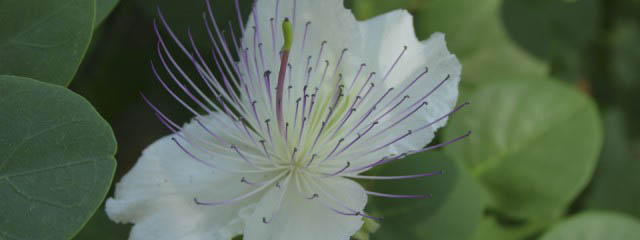Growing capers in Italy
Growing capers in Italy is probably the easiest thing on earth. Wild capers grow and flower profusely on old castles or town walls.
Outside my Italian cottage we have two large bushes carrying a summer wig of white flowers. Or to be quite honest, I have only experienced the profusion of flowers once, as every spring my neighbour, the Contadina, demonstratively rips off each and every one of the delicate flowers with their long purplish-pink stamens and throws them on the ground.
– If the bush flowers, it will not produce berries, and capers are great taste givers. Who needs flowers anyway, she says with determination. My objections that these flowers look quite pretty, are answered with a ‘bo’ which is Apulian for ‘beh’ meaning ‘I don’t know and I couldn’t care less’.
Since then she has consequently deflowered by bushes very early every morning, unless I make sure to get to the flowers first. She also likes to pick the berries, which is one of the tasks one cannot leave to a straniera, though she has started to trust me, after she developed a strange kind of capers allergy on her hands, and had to dress each finger in tissue paper and cellotape. Now I am allowed to harvest my own capers under her strict supervision.
– Remember only to pick the large buds. The small ones absorb too much salt. Mangia sale, she says, and normally I listen and do as I’m told. After all, she has almost 80 years experience in preserving capers, and she has kindly shown me how the flower buds should be nipped and cleaned, before they are placed in sterilized jars and covered in layers of salt and water.
When the bright green buds change colour the capers are ready to eat, and with two old bushes you – and your extended family – will never run out of this kind of food seasoning and garnish. Each summer produces 10-15 jam jars full of capers, which is more than most Scandinavian families consume in a life-time.
In addition I am still allowed to enjoy the sight and smell of the vaguely fragrant flowers every time I pass by old Italian castles or town walls. Caper bushes grow in the most incredible places, but seem to have a preference for ancient stones and archeological sites. You see it climbing the walls of the Colosseum and Forum Romanum, it can be found among the ruins of Pompeii and in column crevices in Pestum and Agrigento.
The only place you will not find capers are in South Italian supermarket and grocery stores. Massive free supplies are available to all locals, and lazy housewives stock up at the olive pusher in the weekly market. He does not, however, sell the big caperberries that I have only ever come across in northern European specialty shops. Therefore I have tried to convince the Contadina that we might leave some flowers on the bush and watch them become berries, but this idea will definitely not take root and grow in her (or her neighbour’s) garden.
Other notes similar to growing capers in Italy
My guide to eating prickly pears
The sweet aspirations of a figtree
Grow pomegranates – a tree of myth and fairytales





Great post. I wonder how easy would it be to grow capers here in Spain.
I’d think they could grown anywhere in the Med, but come to think of it I’ve never seen capers in Spain.